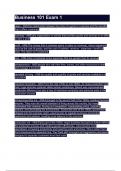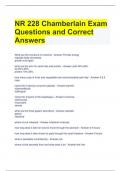Business 101 Exam 1
value - ANS-the relationship between the price of a good or a service and the benefits
that it offers customers
business - ANS-any organization or activity that provides goods and services in an effort
to earn a profit
profit - ANS-The money that a business earns in sales (or revenue), minus expenses,
such as the cost of goods, and the cost of salaries. revenue - expenses = profit (or
loss). The return on investment.
loss - ANS-when a business incurs expenses that are greater than its revenue
entrepreneurs - ANS-people who risk their time, money, and other resources to start
and manage a business
standard of living - ANS-the quality and quantity of goods and services available to a
population
industrial revolution - ANS-From the mid-1700s to mid-1800s. As mass production took
hold, huge factories replaced skilled artisan workshops. Result was unprecedented
production efficiency but also a loss of individual ownership and personal pride in the
production process.
entrepreneurship era - ANS-Emerged in the second half of the 1800s, building business
empires. They rose the overall standard of living across the country, but many
dominated their markets, forcing out competitors, manipulating prices, exploiting
workers, and decimating the environment. Toward the end of the 1800s, government
stepped into the business realm, passing laws to regulate business and protect
customers and workers, creating more balance in the economy.
production era - ANS-Early part of the 1900s, major business focused on further refining
the production process and creating greater efficiencies. Jobs became more
specialized, increasing productivity and lowering costs and prices. This is when Henry
Ford introduced the assembly line. The "hard sell" emerged and aggressive persuasion
designed to separate customers from their cash.
, marketing era - ANS-After WWII, balance of power shifted from producers and towards
consumers. To differentiate themselves, businesses began to develop brands, or
distinctive identities, to help consumers understand the differences among various
products. Marketing concept emerged: a consumer focus that permeates successful
companies in every department, at every level.
relationship era - ANS-Building on the marketing concept, today, leading edge firms look
beyond each immediate transaction with a customer and aim to build long-term
relationships. Satisfied customers become advocates for the business and spread the
word to people around them. One key tool is technology.
nonprofits - ANS-business-like establishments that employ people and produce goods
and services with the fundamental goal of contributing to the community rather than
generating financial gain
factors of production - ANS-five fundamental elements -- natural resources, capital,
human resources, entrepreneurship, and knowledge -- that businesses need to achieve
their objectives
natural resources/land - ANS-Includes all inputs that offer value in their natural state,
such as land, fresh water, wild, and mineral deposits. Most must be extracted, purified,
or harnessed. The value of all natural resources tends to rise with high demand, low
supply, or both.
capital - ANS-Includes machines, tools, buildings, information, and technology -- the
synthetic resources that business needs to produce good or services. It does not
include money, but, clearly, businesses use money to acquire, maintain, and upgrade
their capital.
human resources/land - ANS-Encompasses the physical, intellectual, and creative
contributions of everyone who works within an economy.
entrepreneurship - ANS-Entrepreneurs are people who take the risk of launching and
operating their own businesses. Entrepreneurial enterprises can kick-start an economy,
creating a tidal wave of opportunity by harnessing the other factors of production. The
key ingredient is economic freedom -- freedom of choice, freedom from excess
regulation, and freedom from too much taxation. As well as, protection from corruption
and unfair competition. Most growing economies support and promote
entrepreneurship. KEY FACTOR.





